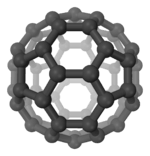Aluminium monochloride
| Names | |
|---|---|
| IUPAC name
Aluminium monochloride | |
| Systematic IUPAC name
Chloridoaluminium[1] | |
| Other names
Aluminium(I) chloride | |
| Identifiers | |
| 13595-81-8 | |
| 3D model (Jmol) | Interactive image |
| ChEBI | CHEBI:30131 |
| ChemSpider | 4514257 |
| PubChem | 5359282 |
| |
| |
| Properties | |
| AlCl | |
| Molar mass | 62.43 g·mol−1 |
| Thermochemistry | |
| Std molar entropy (S |
227.95 J K−1 mol−1 |
| Std enthalpy of formation (ΔfH |
-51.46 kJ mol−1 |
| Related compounds | |
| Related compounds |
aluminium monofluoride gallium monofluoride |
| Except where otherwise noted, data are given for materials in their standard state (at 25 °C [77 °F], 100 kPa). | |
| | |
| Infobox references | |
Aluminium monochloride is the metal halide with the formula AlCl. This compound is produced as a step in the Alcan process to smelt aluminium from an aluminium-rich alloy. When the alloy is placed in a reactor that is heated to 1,300°C and mixed with aluminium trichloride, a gas of aluminium monochloride is produced.[2]
- 2Al{alloy} + AlCl3{gas} → 3AlCl{gas}
It then disproportionates into aluminium melt and aluminium trichloride upon cooling to 900°C.
This molecule has been detected in the interstellar medium, where molecules are so dilute that intermolecular collisions are unimportant.[3]
See Also
References
- ↑ "chloridoaluminium (CHEBI:30131)". Chemical Entities of Biological Interest (ChEBI). UK: European Bioinformatics Institute.
- ↑ Totten, George E.; MacKenzie, D. Scott (2003). Handbook of Aluminum. CRC Press. ISBN 0-8247-0896-2.
- ↑ J. Cernicharo, M. Guelin (1987). "Metals in IRC+10216 - Detection of NaCl, AlCl, and KCl, and tentative detection of AlF". Astronomy and Astrophysics. 183 (1): L10–L12. Bibcode:1987A&A...183L..10C.
This article is issued from Wikipedia - version of the 11/10/2016. The text is available under the Creative Commons Attribution/Share Alike but additional terms may apply for the media files.
